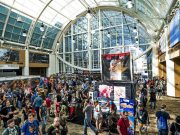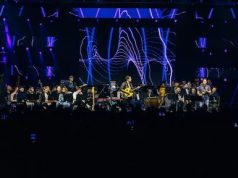by the editorial staff of Seattle24x7.com 
For the last two weeks of this November, Seattle’s On the Boards performing arts organization has hosted an elaborate presentation of Internet data as multimedia art. The installation, which just ended its run at the Behnke Center for Contemporary Performance (100 W. Roy) on its way to its next phasal link at New York City’s Whitney Museum of American Art, was an exercise in dimensionalizing data, the bits and bytes that pulse through thousands of chat rooms across the World Wide Web.
In the Listening Post abstraction, and as Rod Serling used to intone, the Internet is represented as “a dimension of sound;” a single beep or tone to symbolize a lone keyword emitted in the vastness of cyberspace, a communal chord to represent a commonality of expression, and digitized text-to-voice reproduction to enunciate keyword fragments that also appeared on a suspended grid of over 200 alphagrammatic text displays that floated inside the exhibition hall.
The intellectual property put on display in this real-time performance is yours and yours and yours — conversations collected from thousands of chat rooms, forums, bulletin boards and Websites where people communicate with one another in real time. It is what the Internet would sound like if it were a midi composer. In sequence, the datastream is then run through statistical analyses that determine the correlation of the data, topic clusters are formed and the information is run to the display grid and to speakers for pixelated text display, tonal representation and text-to-speech vocalization.
Creators Ben Rubin and Mark Hansen who have both spent the past two weeks here in Seattle as visiting artists in residence, are as contrasting in personality as their respective art forms — aesthetically thought-provoking ambient sound and hard empirical data. But the pair has juxtaposed their creative disciplines for this project and in their other ancillary pursuits. After meeting at a multimedia symposium, the partnership originated as a kind of arranged marriage that the Brooklyn Academy of Music (BAM) and Lucent Technologies put together.
In fact, Listening Post was recognized in the New York Times as something of “a coming-out party” for the technically adept Mr. Rubin, who is 37 and a graduate of the M.I.T. Media Lab. Although he works frequently with some of New York’s leading artists, he is rarely in the spotlight. But he has collaborated on major projects with the composer Steve Reich and the video artist Beryl Korot (“The Cave”) as well as with the musicians Laurie Anderson and Arto Lindsay. Mr. Hansen is a member of the Technical Staff, Statistics and Data Mining Research Dept of Bell Labs.
“In our first experiment together,” said Ben, “a kind of proof of concept, — we took Web logs of hits on Lucent’s Website and created a sound mapping. It yielded the sound of Lucent’s website at 6 o’clock in the morning, a bit of a sleepy sound. The beeps and tones represent hits.” Mark chimes in, “The way we designed the mapping, the sound is supposed to become more expressive as more and more people are doing interesting things on the site, where interest is registered as access to content.”
The Listening Post grew out of the prototype. “We took off on the idea that the Web as it stands now is a massive communications channel,” said Ben. “We wanted to do something about characterizing the millions of conversations that happen each day. We decided to see if we could say something about chat. And we started with just a single chatroom. We created some software agents that could analyze the discussions that were going on in a single room. Later these scaled up to many rooms.”
The pair started listening to a chatroom at www.financialchat.com, a Website which served stock market daytraders. The top layer of data abstraction was a sampling of chat phrases. In the background, an algorithmically generated piano was orchestrated that became more and more elaborate as the entropy in the room increased.
Despite the artistic setting for Listening Post, the project represents serious research that may eventually yield a commercial product. For instance a Webmaster might use this system to monitor online activity, with discordant sounds signaling a problem that needs attention.
Ultimately, Listening Post reaffirms how many Internet-based artworks contain a strong performance element. An artistic interpretation of the global digital media stream has already been made into a source of entertainiment as randomized visual mosaics — Web jpegs and gifs — as well as a tiled compilation of Web pages. Listening Post has succeeded in transcending the same “order from chaos” theme in the audible realm. In supersonic Seattle, it rather impressively managed to break the Internet-as-art sound barrier. [24×7]

















